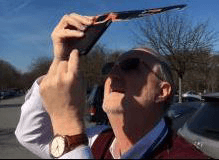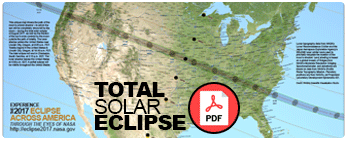Smartphone Photography of the Eclipse
Most of the ‘beauty shots’ you will see related to this eclipse will be taken with professional digital cameras on tripods, or shot through a telescope, but the most common photos you will probably see will be taken by the millions of smartphones used by ordinary people to capture this event. These will generally not look very good with the typical smartphone system, but with a bit of preparation, you will be able to create some stunning pictures! Here are some general guidelines for taking successful smartphone images, followed by some detailed suggestions for inexpensive equipment you will need to really see some impressive details.
- Practice photographing the full moon to get an idea of how large the sun-in-eclipse will appear with your smartphone’s lens, or with a telephoto lens attachment. Moon photography is a challenge because the camera will try to automatically adjust the exposure but most of the view will be the dark sky, so the moon’s disk will be overexposed and show no details. To get around this, most smartphones let you adjust with your finger where the focus and metering spots will be in the field. The more test shots you can take in the days and weeks before the eclipse, the less time you will waste when the eclipse occurs!
- If you are using a smartphone, you need to make sure the image is properly focused. Don’t count on your auto-focus to do this. You have to do it manually, and this is as simple as tapping the screen and holding your finger on the moon to lock the focus. Then slide your finger up or down to darken or lighten the exposure. On iOS camera apps, tapping an object will center a box around it and show a little sun icon. This is the exposure slider. Drag it down until you see details on the moon image. Android camera apps usually have an exposure setting too, but it might take some hunting around to find it.
- Rather than trying to photograph the eclipse itself, concentrate on what people around you are doing, but perhaps with the eclipsing sun in the field of view too. Take a time-lapse photo series of the scenery as the light dims with the smartphone secured on a tripod or other mounting so that you can watch the eclipse while your camera photographs the scenery. You might even want to shoot some video in the minutes before, during and after to record people’s reactions and the invariable oohs and aahs!
- Digital zoom will not work to create a magnified, clear image. Instead, go buy a $20-$40 dollar zoom lens attachment that will give you 12x to 18x. For moon photography in the days and weeks before the eclipse, this will let you see a large moon disk, resolve mare features, and perhaps see a few large craters. At this magnification, the total solar eclipse will also look much nicer because you will be able to start to see details in the shape of the corona!
- Consider using the delay timer set at 5 seconds so that once you press the exposure button, the camera waits 5 seconds before taking the shot. That gives your camera/tripod/clamp system plenty of time to settle down and produce vibration-free images.
- Without a telephoto attachment to your smartphone, the image of the lunar/eclipse disk will be heavily pixilated, and the corona will look equally rough. This is the normal camera view of a standard smartphone, but if you zoom out for a wide-angle view, you will be able to see the bright corona surrounding a black spot in the sky, but also capture the landscape and local scenery for some superb group photos!
- When manually focusing your smartphone on the enlarged moon. make sure that you center the focus spot on the edge of the moon, which will be a sharp edge for the camera to auto-focus on. Also adjust the light sensor spot manually so that it is metering the corona. You may need to move the metering spot around to get the best contrast and image definition.
- Make sure that for telephoto imagery that you use a tripod because the vibration of your hands will be enough to smear the image and make it very difficult to focus on it.
- Make sure that you STOP your photography to actually VIEW the total solar eclipse with your own eyes!!!

Image Credit: Sten Odenwald NASA/Lou Mayo





